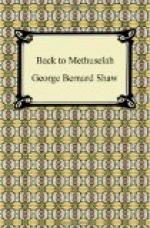THE ARTIST-PROPHETS
And there are always certain rare but intensely interesting anticipations. Michael Angelo could not very well believe in Julius II or Leo X, or in much that they believed in; but he could paint the Superman three hundred years before Nietzsche wrote Also Sprach Zarathustra and Strauss set it to music. Michael Angelo won the primacy among all modern painters and sculptors solely by his power of shewing us superhuman persons. On the strength of his decoration and color alone he would hardly have survived his own death twenty years; and even his design would have had only an academic interest; but as a painter of prophets and sibyls he is greatest among the very greatest in his craft, because we aspire to a world of prophets and sibyls. Beethoven never heard of radioactivity nor of electrons dancing in vortices of inconceivable energy; but pray can anyone explain the last movement of his Hammerklavier Sonata, Opus 106, otherwise than as a musical picture of these whirling electrons? His contemporaries said he was mad, partly perhaps because the movement was so hard to play; but we, who can make a pianola play it to us over and over until it is as familiar as Pop Goes the Weasel, know that it is sane and methodical. As such, it must represent something; and as all Beethoven’s serious compositions represent some process within himself, some nerve storm or soul storm, and the storm here is clearly one of physical movement, I should much like to know what other storm than the atomic storm could have driven him to this oddest of all those many expressions of cyclonic energy which have given him the same distinction among musicians that Michael Angelo has among draughtsmen.




